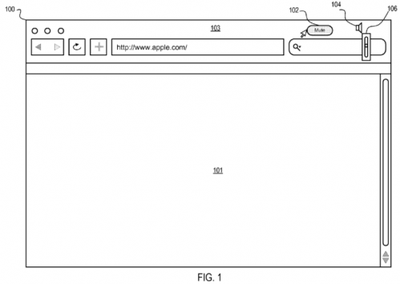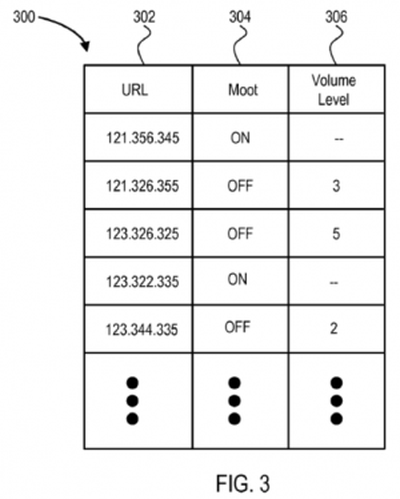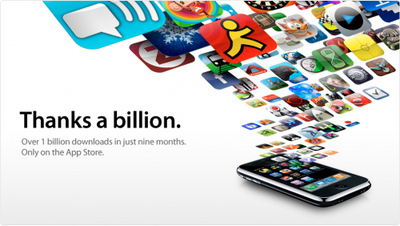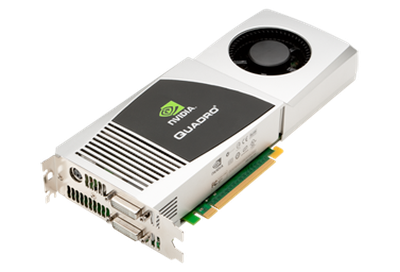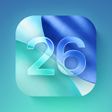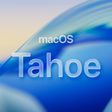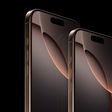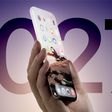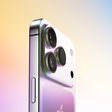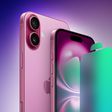Apple today announced financial results for the second quarter of fiscal 2009. Apple posted revenue of $8.16 billion and net quarterly profit of $1.21 billion, or $1.33 per diluted share, compared to revenue of $7.51 billion and net quarterly profit of $1.05 billion, or $1.16 per diluted share, in the year-ago quarter. Gross margin was 36.4 percent, compared to 32.9 percent in the year-ago quarter, and international sales accounted for 46 percent of the quarter's revenue. The numbers represent the best March Quarter revenue and earnings in Apple history.
Using non-GAAP data, which eliminates subscription-based accounting for the iPhone and Apple TV, Apple would have had $9.06 billion revenue and $1.66 billion of net income.
Apple shipped 2.22 million Macintosh computers during the quarter, a unit decline of 3 percent over the year-ago quarter. The company also sold 11.01 million Pods during the quarter, representing 3 percent unit growth over the year-ago quarter. Quarterly iPhone unit sales reached 3.79 million, up 123 percent from the year-ago-quarter.
"We are extremely pleased to report the best non-holiday quarter revenue and earnings in our history," said Peter Oppenheimer, Apple's CFO. "Apple's financial condition remains very robust, with almost $29 billion in cash and marketable securities on our balance sheet."
Apple's guidance for the third quarter of fiscal 2009 includes expected revenue of $7.7 billion to $7.9 billion and earnings per diluted share of $0.95 to $1.00.
Apple will provide live streaming of its Q2 2009 financial results conference call at 2:00 PM Pacific, and MacRumors will update this story with coverage of the conference call highlights.Conference Call Highlights
- Oppenheimer: results exceeded our expectations and very pleased given this economy.
- Mac: for March quarter, sold 2.2 million Macs. 3% decline from year-ago quarter. Difficult to compare since MacBook Air launched last year which boosted sales.
- Very confident in Mac sales
- Music: 3% over year ago quarter. Very strong sales of iPod Touch.
- Customers and reviews responded favorably to new iPod shuffle
- Very pleased with iPod marketshare. Over 70% in U.S. (per NPD)
- Year over year iPod sales growth in a number of international markets
- iTunes Store: strong quarter. A number of changes in iTunes stores: DRM free titles.
- App Store: over 35,000 applications compared to 15,000 as of last conference call. Within hours of reaching 1 billionth download.
- Software is the key ingredient for a great mobile experience.
- Very excited about the prospect of more compelling apps with the iPhone 3.0 OS
- Expanding iPhone's geographic reach. 81 countries.
- March 17th - provided a preview of iPhone 3.0 to developers.
- iPhone 3.0 release will include over 100 features for customers and 1000 new APIs for developers. Very enthusiastic developer response
- Delayed the reporting of revenue of iPhones sold after March 17th until 3.0 ships.
- Commodity prices were significantly lower than expected. sales of higher margin products were better than planned.
- June Quarter outlook: forcasting the current economic environment is challenging. Expect $7.7-7.9 billion in revenue.
- Very pleased with the record March quarter results. Extremely enthusiastic about iPhone 3.0 launch this summer. Very excited about other products in pipeline.
Q/A:
Q: What is your outlook in pricing and component supply in next quarter.
A: We believe that most of the excess inventory was consumed so while we still see the component environment to be favorable, but expect prices to increase during the next quarter. Don't expect to see the same level of reductions we previously saw.
Q: Can you talk about the Mac business? How the new Macs are doing? And ASPs (average sales price)?
A: After we did the desktop launch, we shipped a higher mix of desktops before the transition and that helped the overall ASP down. The Pro products were weaker than in the year ago quarter. We believe that's mainly economic related. In addition, education in the U.S. contracted by about 11% year-over-year -- a result of the states not having the tax revenues for the quarter. Hope to see rebound this year. So, yes, ASPs did decline, desktops were a piece of it. Refreshing all the desktops in a single day really helped us drive more sales in March. The notebook business we did have an ASP decline which was reflective of a push towards the lower end price ($999) Macbooks. As a result, we see the consumer is holding up much better than Pros and Education.
Q: New thoughts on the Netbook at this point?
A: For us it's about doing great products. When I'm looking at what's sold in the Netbook market, I see cramped keyboards, junky hardware, very small screen, bad software. Not a consumer experience that we would put the Mac brand on. As it exists today, we're not interested in nor would it be something customers would be interested in the long term. We are looking at the space. For those who want a small computer that does browsing/email, they might want an iPhone or iPod Touch. If we find a way to deliver an innovative product that really makes a contribution, we'll do that. We have some interesting ideas. The product pipeline is fantastic for the Mac. We've historically exceeded the market rate of growth, especially given this economy is an extraordinary achievement. These netbook sales are propping up the unit numbers for the industry. We are very pleased with our performance.
Q: Any mix of paid and free downloads in the App Store?
A: We don't disclose the free vs paid numbers. We are just hours away from our billionth download and couldn't be happier. One of the keys behind the iPod this quarter despite the economic environment was that the iPod touch doubled year over year. The sum of iPhone and iPod Touch is 37 million units now.
Q: Why maintain exclusivity with AT&T?
A: We view AT&T as a very good partner, the best wireless provider in the U.S. Very happy to do business with them. They have done a good job with the iPhone. We have no plans to change it. Technically, Verizon is on CDMA. We decided to focus on one phone for the entire world, which means you have to go down the GSM route. CDMA doesn't have a life after a certain point in time.
Q: Update on Steve Jobs?
A: We look forward to Steve returning to Apple at the end of June.
Q: Do you care about your market share in the U.S.? And given the lower sales prices, does that change your opinion about Mac pricing?
A: On a worldwide basis, IDC projected that the market contracted by 7% worldwide. On a reported basis, we contracted by 3%. But on a sell through basis we were essentially flat. U.S. was our weakest/largest market but in the U.S. a larger percentage is educational so is subject to recent budget constraints. So, I think that's one reason by the U.S. is disproportionately affected. We saw less Pro Macs being sold in the U.S. compared to other markets which we also attribute to the economy. Do I care, of course, but cycles come and go. We are about making the best computers in the world, not the most. We believe that if we do that over the long term, we will gain marketshare.
Q: Comments about iPhone adoption?
A: We have a plan that keeps us leaders in the iPhone space. We'll make sure we don't leave a price umbrella for people.
Q: Any steps in making it easier for the Apps to be discovered?
A: We're doing a number of things. We include easy to find top 50 and 100 apps both paid for and free. We have them associated in various genres and we are expanding those. So I think the team is making it easy to discover. Games are quite popular. That's one of the reasons why the iPod touch has been such a success.
Q: Competitive landscape for smartphones?
A: Difficult to comment on products that aren't shipping. So nothing I can say about the Pre. We think we're in a great position with a combination of the App Store and the billion app downloads. We think we're years ahead, and we see this product through a "software platform lens". The power of the device and ecosystem is enormous.
End of conference.


